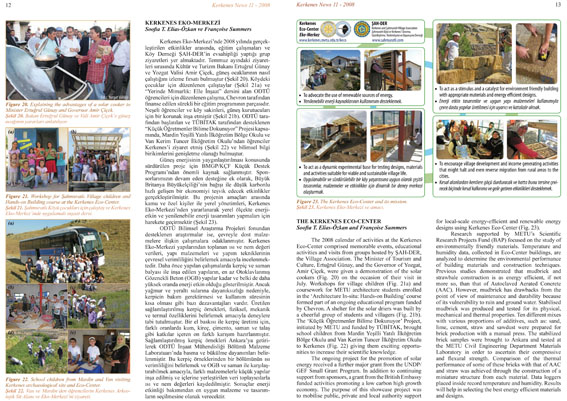| |
THE KERKENES ECO-CENTER
Soofi a T. Elias-Özkan and Françoise Summers
The 2008 calendar of activities at the Kerkenes Eco-Center comprised memorable events, educational activities and visits from groups hosted by ŞAH-DER, the Village Association. The Minister of Tourism and Culture, Ertuğrul Günay, and the Governor of Yozgat, Amir Çiçek, were given a demonstration of the solar cookers (Fig. 20) on the occasion of their visit in July. Workshops for village children (Fig. 21a) and coursework for METU architecture students enrolled in the 'Architecture In-situ: Hands-on Building' course formed part of an ongoing educational program funded by Chevron. A shelter for the solar driers was built by a cheerful group of students and villagers (Fig. 21b). The 'Küçük Öğretmenler Bilime Dokunuyor' Project, initiated by METU and funded by TÜBİTAK, brought school children from Mardin Yeşilli Yatılı İlköğretim Bölge Okulu and Van Kerim Tuncer İlköğretim Okulu to Kerkenes (Fig. 22) giving them exciting opportunities to increase their scientifi c knowledge.
The ongoing project for the promotion of solar energy received a further major grant from the UNDP/GEF Small Grant Program. In addition to continuing support from sponsors, a grant from the British Embassy funded activities promoting a low carbon high growth economy. The purpose of this showcase project was to mobilise public, private and local authority support for local-scale energy-efficient and renewable energy designs using Kerkenes Eco-Center (Fig. 23).
Research supported by METU's Scientific Research Projects Fund (BAP) focused on the study of environmentally friendly materials. Temperature and humidity data, collected in Eco-Center buildings, are analyzed to determine the environmental performance of building materials and construction techniques. Previous studies demonstrated that mudbrick and strawbale construction is as energy effi cient, if not more so, than that of Autoclaved Aerated Concrete (AAC). However, mudbrick has drawbacks from the point of view of maintenance and durability because of its vulnerability to rain and ground water. Stabilised mudbrick was produced and tested for its physical, mechanical and thermal properties. Ten different mixes with various proportions of additives, such as: sand, lime, cement, straw and sawdust were prepared for brick production with a manual press. The stabilized brick samples were brought to Ankara and tested at the METU Civil Engineering Department Materials Laboratory in order to ascertain their compressive and fl exural strength. Comparison of the thermal performance of some of these bricks with that of AAC and straw was achieved through the construction of a miniature structure from each material. Data loggers placed inside record temperature and humidity. Results will help in selecting the best energy efficient materials and designs.
|



